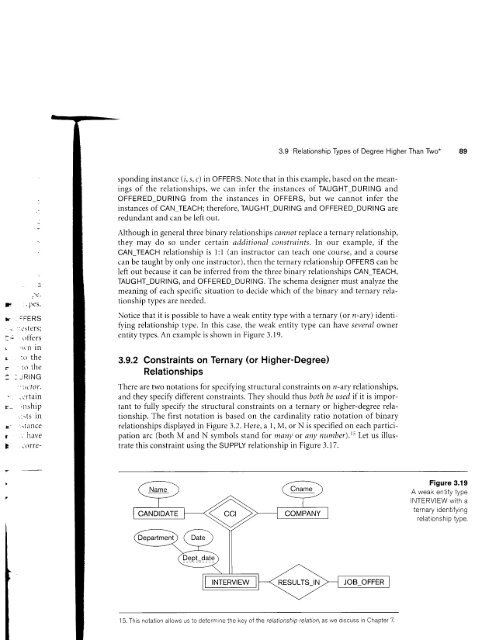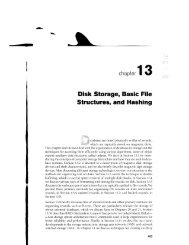this pdf excerpt
this pdf excerpt
this pdf excerpt
You also want an ePaper? Increase the reach of your titles
YUMPU automatically turns print PDFs into web optimized ePapers that Google loves.
lr<br />
.3<br />
1C<br />
,1,.r'<br />
x - =FERS<br />
' . :tasters;<br />
:: trf-fers<br />
r ,\fll in<br />
! l() the<br />
n i() the<br />
: :.JRING<br />
-' itctor.<br />
'- -r'rtain<br />
r.- 'nshiP<br />
,.<br />
:.tS in<br />
.i' I rtilflC€<br />
r<br />
!<br />
i<br />
.. have<br />
;trrre-<br />
3.9 Relationship Types of Degree Higher Than Two*<br />
sponding instance (l, s, c) in OFFERS. Note that in <strong>this</strong> example, based on the meanings<br />
of the relationships, we can infer the instances of TAUGHT_DURING and<br />
OFFERED_DURING from the instances in OFFERS, but we cannot infer the<br />
instances of CAN TEACH; therefore, TAUGHT DURING and OFFERED_DURING are<br />
redundant and can be left out.<br />
Although in general three binary relationships cannot replace a ternary relationship,<br />
they may do so under certain additional constraints. In our example, if the<br />
CAN_TEACH relationship is l:1 (an instructor can teach one course, and a course<br />
can be taught by only one instructor), then the ternary relationship OFFERS can be<br />
left out because it can be inferred from tl-re three binary relationships CAN_TEACH,<br />
TAUGHT_DURING, and OFFERED_DURING. The schema designer must analyze the<br />
meaning of each specific situation to decide which of the binary and ternary relationship<br />
types are needed.<br />
Notice that it is possible to have a weak entity type with a ternary (or n-ary) identitying<br />
relationship type. In <strong>this</strong> case, the weak entity type can have several owner<br />
entity types. An example is shown in Figure 3.19.<br />
3.9.2 Constraints on Ternary (or Higher-Degree)<br />
Relationships<br />
There are two notations for specifying structural constraints on n-ary relationships,<br />
and they specifr different constraints. They should thus both be used if it is important<br />
to fully specif' the structural constraints on a ternary or higher-degree relationship.<br />
The first notation is based on the cardinality ratio notation of binary<br />
relationships displayed in Figure 3.2. Here, a 1, M, or N is specified on each participation<br />
arc (both M and N symbols stand for many or any number).l5 Let us illustrate<br />
<strong>this</strong> constraint using the SUPPLY relationship in Figure 3.17.<br />
15. This notation allows us to determ ne the key ol lhe relatronshrp relation, as we discuss rn Chapter 7<br />
Figure 3.19<br />
A weak entity type<br />
INTERVIEW with a<br />
ternary identifying<br />
rolatinnchin trrnc














